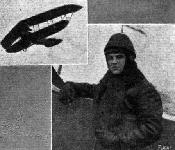J.Herris Roland Aircraft of WWI (A Centennial Perspective on Great War Airplanes 9)
Roland Two-Seaters
Roland's first aircraft designs, the Stahl-Pfeil Doppeldecker and Stahl-Pfeil Eindecker built in 1913 were unsophisticated, unarmed two-seat aircraft designed for reconnaissance and observation in Germany's African colonies. Their airframes were primarily build of steel tubing to give them the robustness needed for this demanding role. Aside from their steel airframes, their engines and configurations were typical of German pre-war designs. Few were built and only two were purchased by the German Air Service before the war.
Журнал Flight
Flight, February 7, 1914.
FOREIGN AVIATION NEWS.
World's Record Duration Flight.
STARTING from Johannisthal on Tuesday at 8 a.m., Langer, on a biplane, made a flight which it is claimed beats the world's record of 13 hrs. 18 mins. made by Fourny on a biplane in September, 1912. After flying round the aerodrome for a couple of hours he went off and made cross-country flights, reappearing at Johannisthal in the evening, and landing at 10.15 p.m.
Flight, February 21, 1914.
FOREIGN AVIATION NEWS.
The Duration Record Nearly Beaten.
ALTHOUGH it failed by the narrow margin of 20 mins. a splendid attempt was made on the 11th inst. by Langer to regain the world's duration record. Starting from Johannisthal he flew to Konigsburg, and was well on his way back when he had to stop owing to his fuel supply giving out at Kreuz near Posen. He had then been in the air for 16 hours. Ingold's record, referred to in last week's FLIGHT, was 16 hours 20 mins.
Flight, September 11, 1914.
AIRCRAFT "MADE IN GERMANY"
WHICH MAY BE EMPLOYED AGAINST THE ALLIES.
24. The L.F.G. Arrow Biplane
has, as its name implies, wings of the back-swept type. The slope backwards of the wings of this machine is very pronounced. Whilst the upper main plane is straight as viewed from in front, the lower one is set at a very pronounced dihedral angle. The machine possesses a large amount of automatic stability laterally, and ailerons are fitted to the tips of the upper plane. At the rear of the rectangular section fuselage are carried the tail planes, which consist of a stabilising plane, to the trailing edge of which is hinged an undivided elevator, and of a balanced rudder mounted wholly on top of the tail plane. A skid formed by three steel tubes protects the tail planes against contact with the ground. Pilot's and passenger's seats are arranged tandem fashion, but very far apart, the passenger being placed immediately behind the engine, whilst the pilot's seat is situated well behind the main plane, about half-way along the fuselage. The chassis is built throughout of steel tubes bent round at the bottom to form short skids, from which is slung the tubular axle by means of rubber shock-absorbers. With a 100 h.p.. Mercedes engine, or an Argus motor of the same power, the speed of the machine is 60 miles per hour.
Flight, September 18, 1914.
AIRCRAFT "MADE IN GERMANY"
WHICH MAY BE EMPLOYED AGAINST THE ALLIES.
28. The Roland (L.F.G.) Arrow Biplane
shown in the accompanying photograph is the actual machine on which the German pilot, Bruno Langer, made some time ago a non-stop flight of sixteen hours' duration, a performance which clearly demonstrates the excellent qualities of both the machine and the 100 h.p. Mercedes engine with which it was fitted.
As a type the Roland biplane is in every way similar to other arrow biplanes, being characterised by the backswept wings, of which the lower one only is set at a dihedral angle, whilst the upper one is straight, as seen from in front. The fuselage is of the usual streamline form, and is rectangular in section. It is covered in front with aluminium sheeting, which has inspection doors cut in it to allow of easy access to the interior.
When used as a two-seater the passenger sits immediately behind the engine, and between him and the pilot's seat is mounted the petrol tank. In front of both occupants are celluloid windscreens mounted on an aluminium framework. For the 16 hours' flight a larger tank was fitted, whilst an additional supply of petrol was carried in the extra tank which may be seen in the photograph mounted just above the fuselage between the cabane struts.
The tail plane of the Taube type is mounted on top of the fuselage, and the rudder is hinged to the rear edge of a small triangular vertical tail fin. A skid formed by three steel tubes takes the weight of the tail planes when the machine is on the ground. The chassis is of the simplest type, consisting of only two pairs of streamline steel tube struts, each pair of which forms a V as seen from the side. The apices of the Vs are connected by a transverse horizontal tube on which rests the tubular axle slung from the angle between the chassis struts by means of rubber shock-absorbers.













